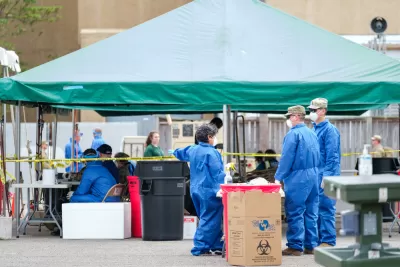The United States currently tests about 145,000 people daily. A Harvard study calls for a minimum of 500,000 daily, but that's on the low end if the country wants to prevent shutting down again due to a second wave of the coronavirus.

"An average of 146,000 people per day have been tested for the coronavirus nationally so far this month, according to the COVID Tracking Project, which on Friday reported 3.6 million total tests across the country," reports Keith Collins for the New York Times on April 17.
To reopen the United States by mid-May, the number of daily tests performed between now and then should be 500,000 to 700,000, according to the Harvard estimates.
The problem with the testing now is that the percentage of positive test results is too high, about a sign that the level of testing is insufficient.
“If you have a very high positive rate, it means that there are probably a good number of people out there who have the disease who you haven’t tested,” said Ashish Jha, the director of the Harvard Global Health Institute. “You want to drive the positive rate down, because the fundamental element of keeping our economy open is making sure you’re identifying as many infected people as possible and isolating them.”
The researchers said that expanded testing could reduce the rate to 10 percent, which is the maximum rate recommended by the World Health Organization. In Germany, that number is 7 percent, and in South Korea, it is closer to 3 percent. [According to Robinson Meyer and Alexis C. Madrigal of The Atlantic, it's 2 percent.]
The Harvard researchers that the rate of daily testing should be at a minimum of 152 tests per 100,000 people each day, a level reached only by Rhode Island. New York, which has conducted the most tests, is testing at 118 per 100,000 people.
A shortage of test kits and technical flaws in the United States significantly delayed more widespread testing of the virus, letting it spread undetected for weeks. With [almost 753,000 cases as of Sunday], the country has the highest number of known cases in the world. [Also on April 19, U.S. deaths from COVID-19 topped 40,000.]
Jha says that we'll have made progress when the current restrictions on testing have been eliminated.
“We need to switch from saying to people, ‘if you have mild symptoms, if you’re not feeling super sick, don’t come and stay at home,’ to ‘if you have any symptoms, you need to come in to get tested right away,’ ” he said.
New study calls for 5 million daily tests (to start)
Jha's colleague, Danielle Allen, a professor at Harvard University's Edmond J.Safra Center on Ethics, is the lead author of a report titled "Roadmap to Pandemic Resilience," set to be released on Monday, that calls for a much higher level of testing combined with two other public health strategies, reports ABC News on April 19.
"What people need to recognize is that a massively scaled-up testing, tracing and supported isolation system is the alternative to national quarantine," Allen said. "We all had to learn PPE [Personal Protective Equipment] and we all had to learn about flattening the curve ... now we have to learn about TTSI."
Test producers will need to deliver 5 million tests per day by early June to safely open parts of the economy by late July, according to the report. To "fully re-mobilize the economy," the country will need to see testing grow to 20 million a day, the report suggests.
Some experts, including Nobel laureate economist Paul Romer, who did not assist in the report but has a similar approach, estimate the country may need more than 30 million tests per day.
Allen appeared on ABC This Week on Sunday morning. George Stephanopoulos, the host, asked her to explain the danger of economic shutdowns being lifted before adequate testing is in place which could lead to future stay-at-home orders resulting from potential second and third waves of the virus.
Calling that approach "adaptive response" in disease control, she said that makes sense when dealing with a contained epidemic, "but it doesn't make sense when you have a global pandemic when entire countries are experiencing the disease, stressing the need for enough "testing, tracing, and supportive isolation to control the disease so we don't see a resurgence."
She then emphasized what Jha said earlier, the testing rate show a reduced percentage of positive results to match South Korea's level of 3 percent.
The blue-ribbon panel the authored the report consists of more than 45 economists, social scientists, lawyers and ethicists. As of posting time, a link to the report was unavailable. Look for it in the comments section below.
Additional reading:
- "The case for ending the Covid-19 pandemic with mass testing," by
-
"Opinion: The best way out of this pandemic is to massively scale up testing. Here’s how to do it," by Danielle Allen, The Washington Post, Apr 10, 2020
FULL STORY: Coronavirus Testing Needs to Triple Before the U.S. Can Reopen, Experts Say

Trump Administration Could Effectively End Housing Voucher Program
Federal officials are eyeing major cuts to the Section 8 program that helps millions of low-income households pay rent.

Planetizen Federal Action Tracker
A weekly monitor of how Trump’s orders and actions are impacting planners and planning in America.

Ken Jennings Launches Transit Web Series
The Jeopardy champ wants you to ride public transit.

Washington Legislature Passes Rent Increase Cap
A bill that caps rent increases at 7 percent plus inflation is headed to the governor’s desk.

From Planning to Action: How LA County Is Rethinking Climate Resilience
Chief Sustainability Officer Rita Kampalath outlines the County’s shift from planning to implementation in its climate resilience efforts, emphasizing cross-departmental coordination, updated recovery strategies, and the need for flexible funding.

New Mexico Aging Department Commits to Helping Seniors Age ‘In Place’ and ‘Autonomously’ in New Draft Plan
As New Mexico’s population of seniors continues to grow, the state’s aging department is proposing expanded initiatives to help seniors maintain their autonomy while also supporting family caregivers.
Urban Design for Planners 1: Software Tools
This six-course series explores essential urban design concepts using open source software and equips planners with the tools they need to participate fully in the urban design process.
Planning for Universal Design
Learn the tools for implementing Universal Design in planning regulations.
Heyer Gruel & Associates PA
Ada County Highway District
Institute for Housing and Urban Development Studies (IHS)
City of Grandview
Harvard GSD Executive Education
Toledo-Lucas County Plan Commissions
Salt Lake City
NYU Wagner Graduate School of Public Service





























